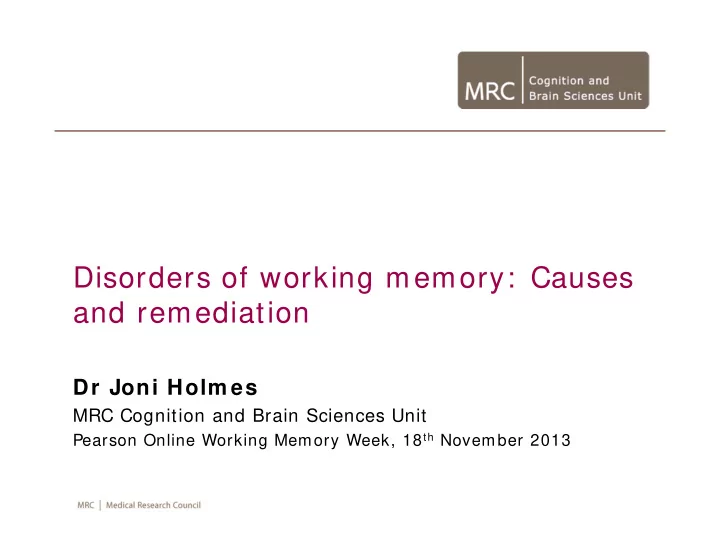

Disorders of working memory: Causes and remediation Dr Joni Holm es MRC Cognition and Brain Sciences Unit Pearson Online Working Memory Week, 18 th November 2013
WM: Key features • Capacity to hold material in mind and manipulate as necessary for brief period • Mental workspace • Limited in capacity - varies between individuals
Children with low working memory • Struggle at school because the working memory loads of individual learning activities are excessive • Fail to complete individual learning exercises • Over time, fail to accumulate knowledge and fall behind peers
WM and Developmental Disorders • Deficits in WM are a common feature in many acquired and genetic developmental disorders of learning • ADHD (Martinussen & Tannock, 2006) • Reading difficulties (Swanson, 2003) • Mathematical difficulties (Geary et al., 2004) • Specific Language Impairment (Archibald & Gathercole, 2007) • Dyslexia (Jeffries & Everatt, 2003, 2004) • Down syndrome (Jarrold, Baddeley & Hewes, 1999) • Williams syndrome (Jarrold, Baddeley, Hewes & Phillips, 2001) • Profiles of children with ADHD and reading difficulties are similar to those of children poor WM
Children with low WM and children with ADHD • 7- to 11-yr old children with: 1. ADHD ( n=83 , no meds ) 2. low WM ( n =50) 3. typical WM ( n =50) Conners Teacher Behaviour Ratings Attainment and IQ 70 110 100 Mean standard scores 60 Mean T-score ADHD ADHD 90 Low WM Low WM Average WM Average WM 80 50 70 40 60 Oppositional Inattentive Hyperactive ADHD Maths Reading Verbal IQ Performance IQ Holmes et al., in prep .
Working memory in ADHD and low WM 120 110 Mean standard score 100 ADHD 90 Low WM Average WM 80 70 60 Verbal STM Visuo-spatial STM Verbal WM Visuo-spatial WM
Working memory in poor readers • 22 poor readers aged 8 – 10 years • 23 typical readers matched for NVIQ Wang & Gathercole, 2013
Low WM, ADHD and reading difficulties • Children with ADHD and those with low WM : i. poor learners ii. inattentive iii. verbal and visuo-spatial WM difficulties • Children with ADHD are more likely to behave impulsively • Poor readers also show i and ii, but have greater verbal than visuo-spatial impairments
Two important questions 1. Are the WM deficits so commonly observed a core feature of different disorders? 2. Does the cause of the WM difficulty limit response to interventions targeted at WM?
1. Are WM deficits core to the disorder? Working memory in its broader context WORKING MEMORY EXECUTIVE FUNCTIONS verbal STM phonological WM inhibitory selective inputs executive control attention control visuo–spatial visuo-spatial STM inputs
Potential sources of WM deficits Phonological/ verbal impairments WORKING MEMORY EXECUTIVE FUNCTIONS verbal STM phonological WM inhibitory selective inputs executive control attention control visuo–spatial visuo-spatial STM inputs
Potential sources of WM deficits WORKING MEMORY EXECUTIVE FUNCTIONS verbal STM phonological WM inhibitory selective inputs executive control attention control visuo–spatial visuo-spatial STM inputs WM executive impairment
Potential sources of WM deficits WORKING MEMORY EXECUTIVE FUNCTIONS verbal STM phonological WM inhibitory selective inputs executive control attention control visuo–spatial visuo-spatial STM inputs Cognitive control impairment
Potential sources of WM deficits Phonological/ verbal impairments WORKING MEMORY EXECUTIVE FUNCTIONS verbal STM phonological WM inhibitory selective inputs executive control attention control visuo–spatial visuo-spatial STM inputs WM executive Cognitive impairment control impairment
2. Does cause limit response to intervention? • Computerised training programs, target working memory • Train on working memory tasks for 25 sessions over a 6-8 week period • Adaptive: individual works at span level
Generalised effects of working memory training RCT with children with poor WM (Dunning, Holmes & Gathercole, 2013)
Cross-group comparisons Preliminary evidence for different patterns of responsiveness to training
Where is the core deficit? Does it predict response to intervention? WM training Deficit A (dyslexic) WORKING MEMORY EXECUTIVE FUNCTIONS verbal STM phonological WM inhibitory selective inputs executive control attention control visuo-spatial STM visuo–spatial inputs Deficit B (Low WM / ADHD) • Children with SLI, using AWMA and Working Memory Diagnostic Instrument (WMDI)
Children with Specific Language Impairments • 14 SLI profile (expressive and receptive language difficulties) • 15 age, gender and NVIQ matches WM scores before training *
Children with Specific Language Impairments WMDI profile before training
Training-related changes in WM scores WM Measure SLI Comparison 105.31 101.48 Verbal STM Digit Recall Word Recall 91.07 103.9 Composite 98.71 100.49 VS STM Dot Matrix 106.06 109.87 Block Recall 103.91 102.52 104.98 106.20 Composite Verbal WM Listening Recall 97.06 104.79 Backward Digit Recall 95.84 108.38 Composite 95.47 105.54 VS WM Mr X 98.31 102.91 Spatial Recall 101.68 108.46 100.00 105.69 Composite Preliminary evidence that cognitive difficulty outside WM may limit response to WM intervention
Summary • Working memory supports learning • Deficits are common in many developmental disorders (and occur independently) • WM impairment might not be a core deficit - could be a secondary consequence of a difficulty elsewhere • Cause of WM difficulty limits response to intervention • WM training generalised improvements in ADHD & low WM groups • BUT constrains response in verbal aspects of WM in children with language problems • Inform choice about intervention
Recommend
More recommend